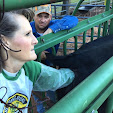The entire month of May all of our blog posts have been about rain, flooding and mud.
Today's blog post will be no different, although it will have a bit of a twist.
May rainfall totals, for the state of Oklahoma, should hit 20" or more.
That is more than half of the states normal yearly average precipitation combined!
Our average yearly precipitation is around 35 inches.
The past 4 years, Oklahoma has experienced severe drought.
So much drought that the 2014 Federal Farm Bill provided a forage disaster program for ranchers.
With all this rain, it is safe to say Oklahoma is no longer in drought conditions.
Farmers wheat and canola fields should be ripening for harvest.
Which they are, but many are also flooded with water.
The cattle have been walking in water soaked fields for up to three weeks now.
They go to higher ground, but the pastures are still water logged.
This brings us to today's main subject.
FOOT ROT!
Foot Rot is a hoof infection.
As the name suggests, it rots away the hoof of the animal.
Most commonly, the infection starts between the toes.
It can be extremely painful and contagious.
The main cause of Foot Rot is moisture, humidity and high temperatures.
This causes the hoof to soften, giving the possibility to damage the area and allow bacteria to infect the foot.
Foot Rot is easy to identify.
The rancher will see a limp in the animal, a swollen foot, and in severe cases, a foul smell.
The swelling will be within 24 hours of the infection.
We see our cattle daily, therefore we are able to detect Foot Rot early and start treatment.
See this girl...
She has Foot Rot!
As do two others in this pasture
Treatment of Foot Rot is with an antibiotic.
Here is where it gets a bit tricky...
There is so much water in the pastures, a truck and trailer would get stuck.
Remember this post?
In these conditions, the best way to treat our cattle is with a dart gun.
We could call in all of Flower Boy's cowboy friends, have the wives and kids seated on tailgates, and have our own form of a ranch rodeo!
Although it might be the best entertainment any of us have had in a while, there is no need in it when one has a dart gun.
The dart gun looks like a normal gun.
It shoots the antibiotic filled dart with a blank .22 bullet.
Drewman pulls the antibiotic into a syringe.
Flower Boy loads the dart with the antibiotic.
Each dart only holds 10cc of antibiotic.
A 1000 pound cow will require more than one dart shot of antibiotic.
The darts have a small barb, on them, to stick into the muscle of the animal.
When the dart hits the animal, a CO2 cartridge in the dart compresses the antibiotic into the animal, thus administering the shot.
Flower Boy takes aim.
He fires the shot.
If you look closely, just above the calf with the orange ear tag, you can see the dart moving through the air.
(I just love my big girl camera!)
It is a direct hit!
With Flower Boy's military and police background, there was no doubt.
A total of three dart shots went to this cow.
By the third shot, she was not a happy momma!
Another momma cow received two dart shots and a smaller bull calf received one.
We will keep close watch on those that were given antibiotics, as well as others that may show signs of Foot Rot.
There may have to be more antibiotics given.
Are you dealing with moisture in your area?
Do you have other health problems within your herd?
We would love to hear from you!
XOXO,
Rancher Girl













No comments:
Post a Comment